ESA’s Cheops finds an unexpected ring around dwarf planet Quaoar
During a break from looking at planets around other stars, the European Space Agency’s CHaracterising ExOPlanet Satellite (Cheops) mission has observed a dwarf planet in our own Solar System and made a decisive contribution to the discovery of a dense ring of material around it.
The dwarf planet is known as Quaoar. The presence of a ring at a distance of almost seven and a half times the radius of Quaoar, opens up a mystery for astronomers to solve: why has this material not coalesced into a small moon?
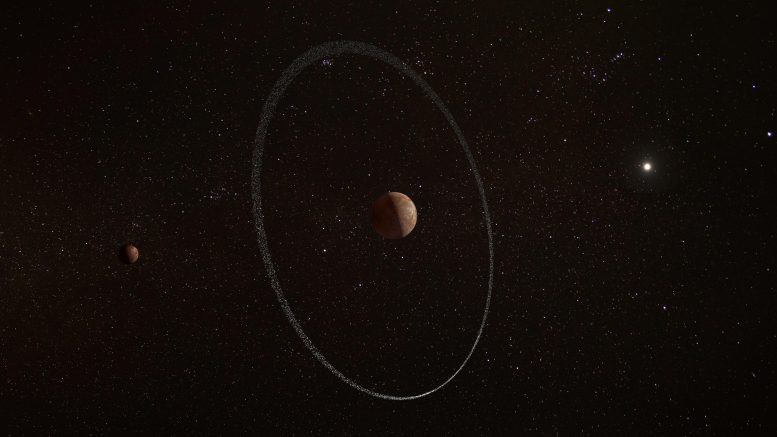
An artist’s impression of the dwarf planet Quaoar and its ring. Quaoar’s moon Weywot is shown on the left. Quaoar’s ring was discovered through a series of observations that took place between 2018 to 2021. Using a collection of ground-based telescopes, and ESA’s space-based telescope Cheops, astronomers watched as Quaoar crossed in front of a succession of distant stars, briefly blocking out their light as it passed. Credit: ESA, CC BY-SA 3.0 IGO
How to observe distant objects in the Solar System
The ring was discovered through a series of observations that took place between 2018 to 2021. Using a collection of ground-based telescopes, and the space-based telescope Cheops, astronomers watched as Quaoar crossed in front of a succession of distant stars, briefly blocking out their light as it passed.
Such an event is known as an occultation. Observing how the light from the occulted star drops provides information about the occulting object’s size and shape, and can reveal whether the intervening object has an atmosphere or not. In this case, smaller drops before and after the main occultation betrayed the presence of material in orbit around Quaoar.
Quaoar is one of a collection of small, distant worlds known as trans-Neptunian objects (TNOs). Roughly 3000 are known. As the name suggests, TNOs are found in the outer reaches of the Solar System, beyond the orbit of planet Neptune. The largest of the TNOs are Pluto and Eris. With an estimated radius of 555 km, Quaoar ranks around number seven on the size list, and is orbited by a small moon called Weywot, roughly 80 km in radius.
Studying these dwarf planets is difficult because of their small sizes and extreme distances. Quaoar itself orbits the Sun at almost 44 times the Sun-Earth distance. So, occultations are particularly valuable tools. Until recently, however, it has been difficult to predict exactly when and where they will take place.
For an occultation to occur, the alignment between the occulting object (here the TNO), the star, and the observing telescope must be extremely precise. In the past, it has been almost impossible to meet the stringent accuracy requirements to be certain of seeing an event. Nevertheless, to pursue this goal the European Research Council Lucky Star project, coordinated by Bruno Sicardy, Sorbonne University & Paris Observatory – PSL (LESIA), was created to predict upcoming occultations by TNOs, and to co-ordinate the observation of these events from professional and amateur observatories around the globe.
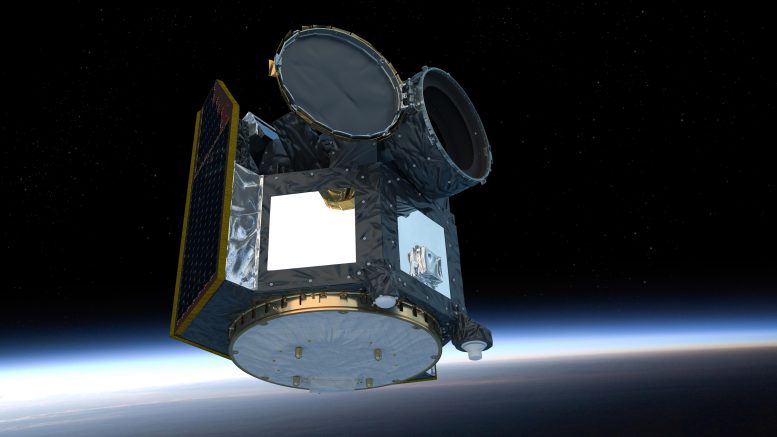
Artist’s impression of Cheops, ESA’s Characterising Exoplanet Satellite, in orbit above Earth. In this view the satellite’s telescope cover is open. Credit:
ESA / ATG medialab
Precise alignment
Recently, the number of observed stellar occultations has increased. In large part, this is due to the contribution of data from ESA’s star mapping mission Gaia. The spacecraft has delivered such stunning accuracy in its stellar positions that the predictions made by the Lucky Star team has become much more certain.
One of the people involved in the Lucky Star project is Isabella Pagano of the INAF’s Astrophysical Observatory of Catania, Italy, and a member of the Cheops Board. Isabella was contacted by Kate Isaak, ESA’s Project Scientist for the Cheops mission, who was curious whether the space telescope would also be able to catch an occultation.
“I was a little skeptical about the possibility to do this with CHEOPS,” admits Isabella, “But we investigated the feasibility.”
The main issue was that the satellite’s trajectory can be slightly modified because of drag in the upper parts of the Earth’s atmosphere. This is due to the unpredictable solar activity that can hit our planet and puff up its atmosphere.
Indeed, the first time the team attempted to observe an occultation with Cheops, which involved Pluto, the prediction was not quite accurate enough, and no occultation could be observed.
The alignment was more favourable on the second attempt, however, when they observed Quaoar. In doing so, they made the first ever detection of a stellar occultation by a trans-Neptunian object from space.
Put a ring on it
“The Cheops data are amazing for signal to noise,” says Isabella. The signal to noise is a measure of how strong the detected signal is to the random noise in the system. Cheops gives a great signal to noise because the telescope is not looking through the distorting effects of the Earth’s lower atmosphere.
This clarity proved decisive in recognizing Quaoar’s ring system because it allowed the researchers to eliminate the possibility that the drops in light were caused by a spurious effect in Earth’s atmosphere. By combining several secondary detections, taken with telescopes on Earth, it was possible to be certain that they were caused by a ring system surrounding Quaoar.
Bruno Morgado, Universidade Federal do Rio de Janeiro, Brazil, led the analysis. He combined the Cheops data with that from large professional observatories around the world and amateur citizen scientists, all of whom had observed Quaoar occult various stars over the last few years. “When we put everything together, we saw drops in brightness that were not caused by Quaoar, but that pointed to the presence of material in a circular orbit around it. The moment we saw that we said, ‘Okay, we are seeing a ring around Quaoar.’”
When it comes to ring systems, the giant planet Saturn holds the crown. Known as the ringed planet, Saturn boasts a collection of dust and small moonlets that circle the planet’s equator. In spite of being an impressive observational sight, the mass of the ring system is quite small. If collected it would make between one-third and one half the mass of Saturn’s moon Mimas, or about half the mass of Earth’s Antarctic ice shelf.
Quaoar’s ring is much smaller than Saturn’s but no less intriguing. It is not the only ring system known to exist around a dwarf or minor planet. Two others – around Chariklo and Haumea – have been detected through ground-based observations. What makes Quaoar’s ring unique, however, is where it is found relative to Quaoar itself.
The Roche limit
Any celestial object with an appreciable gravitational field will have a limit within which an approaching celestial object will be pulled to pieces. This is known as the Roche limit. Dense ring systems are expected to exist inside of the Roche limit, which is the case for Saturn, Chariklo and Haumea.
“So, what is so intriguing about this discovery around Quaoar is that the ring of material is much farther out than the Roche limit,” says Giovanni Bruno, INAF’s Astrophysical Observatory of Catania, Italy.
This is a mystery because according to conventional thinking, rings beyond the Roche limit will coalesce into a small moon within just a few decades. “As a result of our observations, the classical notion that dense rings survive only inside the Roche limit of a planetary body must be thoroughly revised,” says Giovanni.
Early results suggest that the frigid temperatures at Quaoar may play a role in preventing the icy particles from sticking together but more investigations are needed.
“The Cheops observations have played a key role in establishing the presence of a ring around Quaoar, in an application of high precision, high cadence photometry that goes beyond the more typical exoplanet science of the mission,” says Kate.
While the theoreticians get to work on how the Quaoar rings can survive, the Lucky Star project will continue to look at Quaoar and also other TNOs as they occult distant stars to measure their physical characteristics and see how many others also have ring systems.
And Cheops will return to its original mission to study nearby exoplanets.
Reference: “A dense ring of the trans-Neptunian object Quaoar outside its Roche limit” by B. E. Morgado, B. Sicardy, F. Braga-Ribas, J. L. Ortiz, H. Salo, F. Vachier, J. Desmars, C. L. Pereira, P. Santos-Sanz, R. Sfair, T. de Santana, M. Assafin, R. Vieira-Martins, A. R. Gomes-Júnior, G. Margoti, V. S. Dhillon, E. Fernández-Valenzuela, J. Broughton, J. Bradshaw, R. Langersek, G. Benedetti-Rossi, D. Souami, B. J. Holler, M. Kretlow, R. C. Boufleur, J. I. B. Camargo, R. Duffard, W. Beisker, N. Morales, J. Lecacheux, F. L. Rommel, D. Herald, W. Benz, E. Jehin, F. Jankowsky, T. R. Marsh, S. P. Littlefair, G. Bruno, I. Pagano, A. Brandeker, A. Collier-Cameron, H. G. Florén, N. Hara, G. Olofsson, T. G. Wilson, Z. Benkhaldoun, R. Busuttil, A. Burdanov, M. Ferrais, D. Gault, M. Gillon, W. Hanna, S. Kerr, U. Kolb, P. Nosworthy, D. Sebastian, C. Snodgrass, J. P. Teng and J. de Wit, 8 February 2023, Nature.
DOI: 10.1038/s41586-022-05629-6
Cheops is a collaboration between the European Space Agency (ESA) and a consortium of 11 countries, led by Switzerland and the University of Bern. The consortium, including Austria, Belgium, France, Germany, Hungary, Italy, Portugal, Spain, Sweden, and the UK, has made significant contributions to the mission.
ESA holds the role of mission architect, managing the procurement and testing of the satellite, launch, early operations, and in-orbit commissioning, as well as the Guest Observers’ Program that allows scientists worldwide to observe with Cheops. Airbus Defence and Space in Madrid, Spain is the prime contractor for the spacecraft’s design and construction.
The Mission Operations Centre for the Cheops mission is located at INTA near Madrid, Spain, while the Science Operations Centre is based at the University of Geneva, Switzerland. Both centers are run by the consortium.

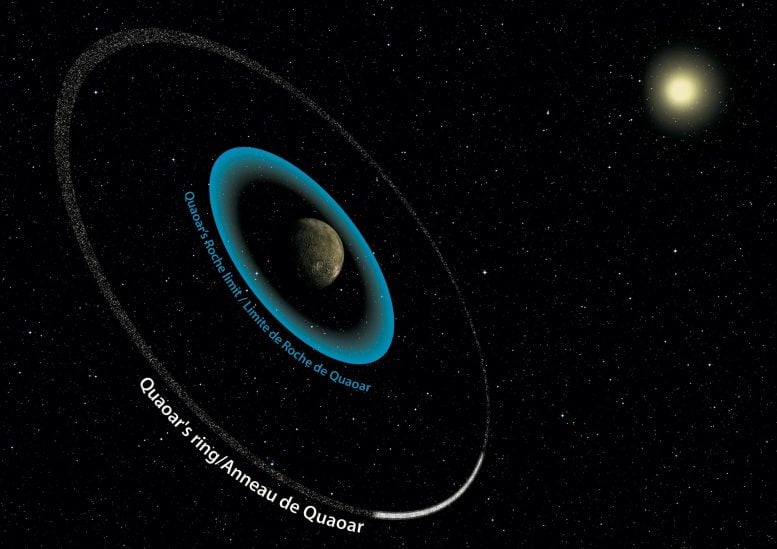
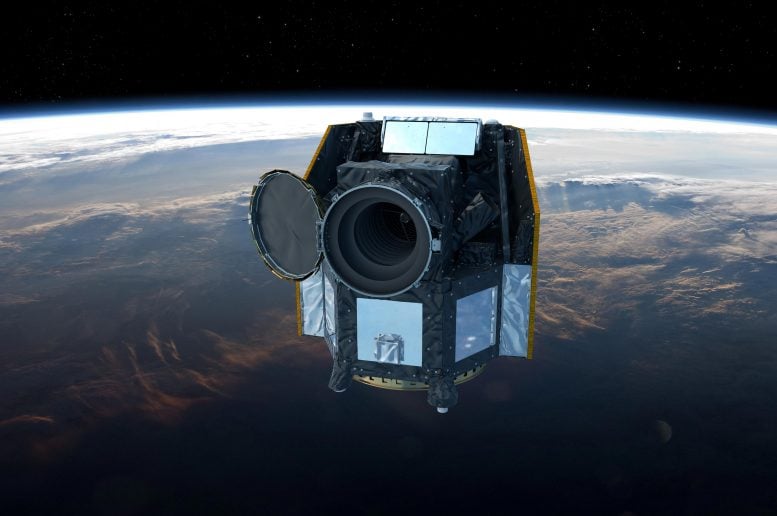
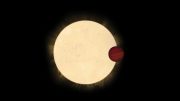

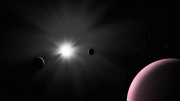
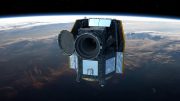
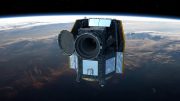
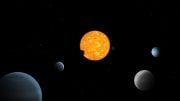
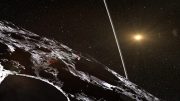
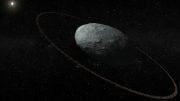
To quote Bruno Morgado’s statement “When we put everything together, we saw drops in brightness that were not caused by Quaoar, but that pointed to the presence of material in a circular orbit around it. The moment we saw that we said, ‘Okay, we are seeing a ring around Quaoar.’”
That moment happened when Jonathan Bradshaw, Renato Langersek and John Broughton, three citizen astronomers from Queensland Australia who are co-authors of the mentioned Nature paper, compared their occultation data on August 27th 2021. After that, the previously collected data was checked by the professionals again and the ring was confirmed.